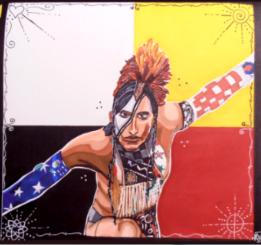I ended 2019 on a great note by getting
into the holiday spirit with friends and family. Most of the holiday activities
I participated in were described as “Christmas” events, but for those of us
whose winter holiday festivities aren’t about honoring Christ the Christian
Messiah, I think it makes more sense to say we’re celebrating Winter Solstice—the worldwide winter festival
time that Christmas got overlapped on top of.
This year my friends Dan and Christine and I had the pleasure and honor of spending Winter Solstice day with a few hundred members of southeastern Michigan’s urban Native American community, hosted by American Indian Health and Family Services (AIHFS) of Detroit, at U of M Dearborn’s Kochoff Hall.
This Winter Solstice celebration—as Winter Solstice celebrations worldwide typically do—included all the core secular elements that people typically associate with Christmas: Winter seasonal decorating and lighting, gathering together as family and community, feasting together, telling stories, and giving gifts and charitable donations.
When we first arrived, we
were directed to the sacred fire outside the building, where AIHFS volunteer
Glen explained to us the tradition of offering prayers at the fire along with
tobacco, cedar, and sweet-grass. After we offered prayers and symbolically
purified ourselves with the smoke from the fire, we entered the hall and joined
the lively and welcoming community inside. We were greeted by AIHFS staff who
sincerely thanked us for coming and gave us Feast Bundles as gifts, even though we’d
brought our own.
We dropped off our contributions at the potlatch table, took a few items for ourselves in return, then headed into the main room. We met some awesome new people, then toured the participating vendors selling jewelry and other Native-made goods, or advertising current social-justice initiatives such as the anti-nuclear-power organization C.R.A.F.T. We then enjoyed a delicious meal inspired by the traditional diet of Native people in this area—and probably beyond, since the Metro Detroit urban Native community represents at least a dozen tribes, if not more. After the meal, community elders told teaching stories, and the women’s drum group and the men’s drum group performed traditional and contemporary honor songs.
I’ve always felt a
resonance with the local Native community, even though some of my maternal
ancestors are Cherokee, not Ojibwe or Potawatomi or Odawa. Thankfully for me, the traditional definition of "Indian" is more about one's participation in and contribution to the community than it is about one's blood quantum. As the descendant of a family that didn't maintain any tribal connection past the early 1900s, I had no childhood opportunities to become "acculturated," to use AIHFS Chairman John Lemire's term.
As an adult, I first formed a connection with the urban Indian community by
attending Wednesday social nights at the North American Indian Association of Detroit (NAIA) from
1999 through the mid-2000s. Since I came to the community with no agenda other than to become
as much a part of it as I could, I’ve never been treated as anything other than
Native when I show up. Neither have any of my friends or family I’ve ever
brought to community events at NAIA or AIHFS, regardless of if they were white,
black, East Asian, Middle-Eastern, or spoke with an accent from another
country.
At one powwow I attended many years ago, I heard someone say, “If you’re here, you’re Indian!”—meaning, you demonstrated you belong by showing up with a desire to respectfully participate and learn, not as a tourist or an assimilationist.
When I looked around the
room at this Solstice celebration, I was delighted to see the diversity of the
urban Native community, including white, black, and probably other racial
categories mixed in. Indians truly “come in all colors” these days, which gives
the pan-Indian community valuable allies within
and beyond the local area.
This was the most soul-refreshing holiday experience I’ve had in a long time. It was also an excellent reminder of the value of this community, and what it has to teach the surrounding mainstream about strength of character and love and adaptation to the times, in the midst of a society that has done everything possible to try and destroy their way of life.
While Native communities across the continent have suffered irreparable harm at the hands of the larger society, such gatherings give me hope that there will continue to be Native culture, community, and identity to pass on to future generations, as long as people keep gathering and telling the stories and sharing the food and crafts and love and lessons as they did in Dearborn on the shortest day of 2019.
Image: “Bracelet from John” by Karla Joy Huber, 2007; colored pencil






